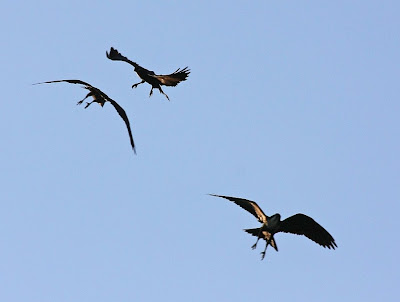
On arrival at the nest tree it offered the branch to its mate, and then took it to the nest. It flew off several more times, each time 'attacking' a treetop, procuring a branch and returning with it.

How to hold this thing? I bet it would have no problem with chopsticks!
Once it dropped a stick it was carrying but retrieved it in mid-air.

All three birds were very vocal, especially the juvenile. It could be distinguished from the adults by the larger white throat patch, the pale whitish eye, and the browner, white-speckled underparts.

The Bat Hawks are nesting in a tualang tree, which is also the residence of choice for wild honey bees. I witnessed an amusing encounter between the juvenile Bat Hawk and a persistent bee! Bee versus Bat Hawk - who will win?

First skirmish - the Bat Hawk is clearly uncomfortable. It kept shaking its foot, as if it had been stung.

The Bat Hawk decides to move away from the bee, but the bee follows!

Direct confrontation! "Just BUZZ OFF @#*!!!"

From bad to worse - the Bat Hawk loses its balance, and literally ...

...falls off its perch!

To add insult to injury, the branch breaks! Bat Hawk 0 - Bee 1. The underdog wins again!

The Bat Hawk decides it's safer in the air.

The parents return.

The juvenile goes to meet them.

Another distinguishing feature of the juvenile is the pointed tail feathers, which still have traces of down at the tips.

How many secondaries? Most birds have 10 primaries and 10 secondaries, but Bat Hawks seem to have at least 11 secondaries, and maybe up to 13, depending on where the tertials end.

Another interesting feature is their enormous gape - more like a swift or nightjar than a raptor - presumably all the better for swallowing bats with!


Yet another is the extremely long legs, which seem 'double-jointed'. Perhaps these are deigned for ripping branches off trees?

And then there are those amazing eyes. I suppose they are large because they hunt predominantly at dawn and dusk, but the colour of them is almost luminous!

This is one of the adults - the male I think - on another tree-bashing foray.

In good light, I was surprised to see that the underwing is actually brown rather than black.

"Look what I brought you dear!" "Oh great - another stick!"

The juvenile coming back for more bee aggro.

Here's comes the male with ... a crowbar? No, another stick.

The juvenile tries its luck begging for food - unsuccessfully. How about a stick?

An adult displaying yet another interesting feature - a pastel pink gape...

...which sometimes shows through the chin feathers!

The juvenile in Mach 3 mode!

And at a slightly more leisurely pace.

Giving me an inspection.

The juvenile landed on a much lower tree, enabling me to get closer than previously. Unfortunately I didn't have my tripod so not too sharp!

One final shot of the juvenile - what awesome birds Bat hawks are!
No comments:
Post a Comment